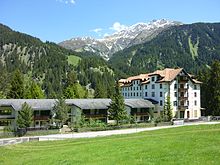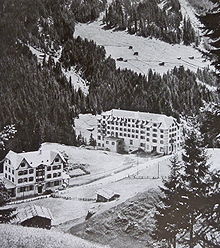Teniger bath
The Tenigerbad ( Rhaeto-Romanic Bogn Tenigia ) is a former spa in Val Sumvitg in the municipality of Sumvitg in Surselva in the canton of Graubünden .
history
Beginnings
The bath was built around the gypsum spring containing Epsom salts and was first mentioned in 1580. At that time, Caspar Cunrad Vielli purchased the bathroom from the community and committed to maintaining and heating it as soon as eight people came together. It was used by the residents of the Somvix community. In 1670, district judge Clau Maissen bought the bath. He expanded the bathing room into a bath house and built a wooden house with several rooms and a dining room. In 1674 he built the Nossa Dunna della Neiv (Our Lady of the Snow) chapel next to the spring , which is still standing today.
To 1900
In the early 19th century, the healing spring was primarily used as a "farmer's bath", in which the guests had to provide their own accommodation and food. In 1814, Disentis Pater Placidus a Spescha , known for his natural history research and alpine achievements, planned to let the Disentis Abbey take over the bath , but the project was never implemented. In 1874, the majority of the local spa guests still bathed in wooden troughs into which the spring water ran via open pipes.
In 1881 Alexander Cagenard built the first stone bath building. The Kurhaus had three floors, a dining room, an inn and 16 rooms for a total of 32 guests. In an advertising brochure from the first health resort doctor Florin Decurtins from 1882, primarily "catarrh of the respiratory tract, chronic rheumatic and gouty complaints, chronic skin rashes and bladder catarrh" are dealt with. Employing your own doctor was an important step towards a professionalized spa and bathing establishment.
Stanislaus Caplazi acquired Quelle and Bad around 1886, which marked the beginning of a period of modernization in the remote valley. In 1892 Caplazi had a dépendance with a veranda built, in 1896 the stone hotel building was increased by one storey and a large dining room was set up. Large investments were also made in the technical area, equipping the Tenigerbad for the spa guests with almost urban comfort with sewerage, cooling systems, electrical lighting, heating and telephone and telegraph connections. Nevertheless, the local population still had the opportunity to use the source for drinking cures and baths at favorable rates, such as the agreement between the health resorts and the Small Council of the Canton of Graubünden on the “reduction of tourist taxes and food costs for poor and less well-off people in need of a spa” 1896 shows. However, the management reserved the right to “designate the hour of the day for each applicant to bathe and drink” and was authorized “to reject persons entirely who, as a result of illness or their outward appearance, would harm the establishment or cause offense” . The season lasted from the end of May to September. Most of the guests, mostly Swiss as well as some Germans and Italians, stayed in the Tenigerbad for a long time; the longest stay is 74 days. In 1892 the pension price was CHF 4.50 including a spa.
20th century
In 1905 two engineers built a small power station in the farthest part of the valley near the reservoir. The cables were rolled out in spring and rolled up again in autumn and brought to safety. On January 29, 1907, the "Waldhaus AG Somvixertal" was founded, which from 1908 to 1910 constructed the two hotel buildings "Waldhäuser" in an elevated clearing above the old Tenigerbad hotel. The main building, inaugurated on July 5, 1908, was over 80 meters long and had four floors. The south-facing rooms had wooden balconies. A mineral bath was set up on each floor. There was also a large dining room, several salons, a darkroom, a pharmacy, our own laundry, a billiard room , a hairdressing salon and our own post office with telephone and telegraph . All rooms were electrically heated and lit. In the Dépendance guests stayed with more modest demands. An extensive park stretched around the hotel complex. The director of the forest houses was Robert Tuor, the former director of the Hotel Disentiserhof in Disentis , also a spa with a spring.
The two new forest houses were not financially viable. They were too little known and were not allowed to use the prestigious name «Tenigerbad». In 1911 Stanislaus Caplazi sold his Tenigerbad with source, electricity company and company name for 300,000 francs to the new Waldhäuser und Tenigerbad AG . Caplazi hired them as managing director of the small spa for all three houses and 220 beds. At the same time, a glass terrace was added and the lounge area in the forest house was enlarged.
The heyday of the Teniger baths ended with the outbreak of World War I; the international guests left. In order to compensate for the absence of guests during the war, German prisoners of war were interned from May 1916 to summer 1917. Classes took place in the hotel buildings; among others in the subjects of bookkeeping, German, English, French, calligraphy and singing.
After the war, the Tenigerbad was increasingly geared towards families with children who wanted to relax in the car-free valley due to poor business activity, shorter stays for guests and investments in the hotel infrastructure that were made too late. the importance of the spring and the spa took a back seat. On June 15, 1933, Stanislaus Caplazi, director of the Teniger baths for many years, died; until 1937 his son Florin continued the business as director.
Business was slow; the utilization was between 40 and 50 percent and the profits were accordingly meager. In addition to rising advertising costs, there were high annual installation costs; a cooling system was installed in 1935 and running water was installed in all rooms in the forest house in 1936. It is unclear whether the hotel was open every season; the license for spa doctors has gaps. It is also conceivable that the hotel was run without a doctor, which also indicates difficulties with which the hotel was struggling. Directors and spa doctors changed frequently.
In 1940 the hotel remained closed due to the politically uncertain situation and in 1941 only the main building was open, the old Tenigerbad and the Dépendance remained closed. In 1946 and 1947 Jon Wieser took over the hotels, after which the business was continued under a Mr. Wille from Ems until 1949. The last director, Mr. Giesiker from Solothurn, took over the hotel in 1950. It was closed a year later.
Between 1953 and 1958, the forest houses served as holiday camps for children; Among other organizations, Pro Juventute Zurich also organized camps for children of Swiss abroad. The Ferroni siblings from Bonaduz were in charge of the camps. The houses were then owned by the Graubündner Kantonalbank .
In 1962 the "Tenigerbad AG Mineralheilbad und Klimastation im Somvixertal" was founded with headquarters in Chur , which was planning a new building. The main shareholder was the industrialist Ernst-Ludwig Schulz from Frankfurt am Main. Construction began in 1971; the teniger bath was modernized with high medical standards. The dépendance was demolished and replaced by a new building designed by the architect Albert Schoch with 150 beds and three bathrooms, including an outdoor pool next to the Kurhaus. Pius Tomaschett became a spa doctor. The total cost was around 15 million francs. In 1974 the new facility was opened under the name "Tenigerbad im Somvixertal". Numerous cultural offers such as readings, concerts and exhibitions were offered, and guided hikes and excursions were also on the program. The hotel should remain open all year round. After the first successful season with 4,000 overnight stays, the guests stayed away and after only three years of operation the facilities were closed in spring 1977. In 1978, the bankruptcy of "Tenigerbad AG" was opened.
Ideas for using the building as a home for asylum seekers or as troop accommodation failed in 1980 due to a study that classified the valley as being at risk of avalanches. Plans to market the mineral water or to convert it into apartments failed in 1990. Apart from a few renovations and the renovation of the roof, little happened. To this day, the Tenigerbad has not been used, despite its full functionality and furnishings.
After the death of the last owner in spring 2015, the further use of the Teniger bath is uncertain.
Trivia
For the musician Ursina Giger from nearby Disentis , the empty building was the inspiration for the song "The House".
gallery
Effects
Despite the financial failure, the positive effects of the Teniger bath on the development of Val Sumvitg were great. First the poor population got the opportunity to use the healing baths, later numerous jobs were created for locals in the service sector as well as a considerable market for agricultural products. In addition, running water and electricity reached the remote mountain valley decades earlier than would otherwise have been the case.
literature
- Konrad J. Kuhn: Mineral springs and health resorts: reflections on the history of alpine tourism in the Bündner Vorderrheintal In: Histoire des Alpes - Storie delle Alpi - History of the Alps, 14 (2009), Zurich: Chronos. Pp. 199-213.
- Konrad J. Kuhn: The health resort Tenigerbad in Somvixertal: On the history of spas, tourism and the hotel industry in the Bündner Oberland In: Bündner monthly newspaper - magazine for Bündner history, regional studies and building culture, 1/2008. Chur: Casanova. Pp. 3-39.
- Adolf Collenberg: Tenigerbad. In: Historical Lexicon of Switzerland . 2012 .
further reading
- Annatina Nay: Too many guests disturb the peace and quiet of the bathroom: But being too quiet is also unhealthy. The history of the Tenigerbad Hotel in five acts , Zurich: Limmat Verlag, 2013.
Web links
- Tenigerbad on the platform ETHorama
- Regiun Surselva
- Video aerial photos 2019
Individual evidence
- ↑ Kuhn, KJ (2008): The health resort Tenigerbad in Somvixertal: On the history of spas, tourism and hotels in the Bündner Oberland. Bündner monthly newspaper
- ↑ Southeast Switzerland January 6, 2016
- ↑ Bianca Rezia Ursina - Three Rhaeto-Romanic songwriters ( memento of the original from October 23, 2016 in the Internet Archive ) Info: The archive link has been inserted automatically and has not yet been checked. Please check the original and archive link according to the instructions and then remove this notice. , Swiss television RTR, December 15, 2013
Coordinates: 46 ° 41 ′ 24 " N , 8 ° 57 ′ 25.5" E ; CH1903: seven hundred and sixteen thousand one hundred and forty-seven / 172099








